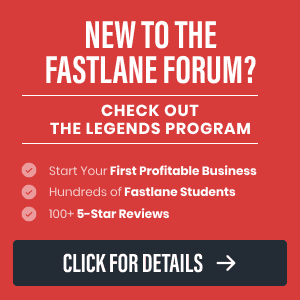TheGeneral
Contributor
User Power
Value/Post Ratio
350%
- Sep 13, 2016
- 10
- 35
Hey All!
This is the start of my progress thread, and I’ll introduce myself to start:
I’m a mid 20’s military veteran. I read Millionaire Fastlane a few years ago and started a business venture around that time. The idea was a web application for the charitable fundraising industry. I hired a local developer who gave me two options: 1)custom coding the entire application, or 2) using a third party backend system to provide the “engine” while the development team worked on the front-end. Fully custom development was priced in the low 6 figures, and the option of using a third party backend cost about $20k-$30k.
The service that provided the third party backend had some amazing salespeople. They answered “YES!” to every question we asked in terms of its functionality. It turns out they highly oversold the system. The project was supposed to take 9 months and cost around $20K, but it took over 2 years (the development team was pretty nice about eating the additional cost).
So 15 months late and over budget, I got a product that simply did not meet expectations.
At that time, I had ZERO experience in computer programming. The night I got the product and realized I had just lost 2 years of time and $20k, I sat down, over a nice cold beer, and thought “had I started to learn programming 2 years ago, I probably could have developed a sellable MVP (Minimum Viable Product) by now”.
The next day I applied for readmission to my state university. I had originally studied two years of business/entrepreneurship before going on military leave. Instead of jumping back into business, I swapped the degree plan over to Computer Science. I kept a minor in business so I could take some additional entrepreneurship classes.
Luckily, I found that I have a passion for programming. It was great. It was like one interesting puzzle after another. Homework was fun instead of a chore, and I was always at the top of my classes. I took the classes more seriously, given my age, previous experience, and passion. I definitely put in much more effort than when I was a partying business student.
I did TONS of self study outside of classes, mostly with Udemy courses. Eventually I was helping my professors by writing tutorials for the classes instead of the regular homework assignments for other students. I developed a couple online web tutorial courses as well.
I built my first fully custom coded web application for a friends construction company in my second year. It was a web based project management software that allowed their project managers to update the project status and access pertinent project information in the field. The code was ugly, but the thing actually worked! I went on to develop about 10 more web applications for various projects, deploying them on dedicated web servers, and managing them as they grew.
While I like to study more complicated aspects of programming and computer science (I’m studying neural networks now), web development is tons of fun for me. It’s not particularly challenging at the programming level. The challenge is more about correctly integrating all the different applications , but it’s really cool to see real live people interacting daily on my sites. It’s great waking up and seeing all the traffic that took place during the middle of the night while I was fast asleep!
I am now fully confident that I could design, develop, and launch the original charitable funding web application. While I still have a lot more to learn, I can definitely launch fully functional MVPs for any ideas I have.
My previous projects all have been developed for clients or personal projects I was not trying to monetize. This time I intend to change that. I intend to develop a SaaS web application, beta test, launch it, market it, and eventually hire on a team of developers that I will oversee. I mean, it sure as hell sounds like a lot more fun than going and getting a job…
My timeline will shoot for a beta test in December/January timeframe. That gives me approximately 3-4 months for design/development. I’m expecting around ~300 hours of development time (20-ish hours a week), plus the additional time needed for opportunity analysis, product definition, market research/analysis, marketing, etc.
I do have some ideas in mind. I will put them on paper, run some numbers, do a simple feasibility analysis, and see what sticks. I will go through that process in the next post.
Please join me in this venture and help me keep my mind focused and on track. I’m sure there is a lot I can learn from this board. Hopefully I can return that favor and provide some value as well. Thanks in advance!
This is the start of my progress thread, and I’ll introduce myself to start:
I’m a mid 20’s military veteran. I read Millionaire Fastlane a few years ago and started a business venture around that time. The idea was a web application for the charitable fundraising industry. I hired a local developer who gave me two options: 1)custom coding the entire application, or 2) using a third party backend system to provide the “engine” while the development team worked on the front-end. Fully custom development was priced in the low 6 figures, and the option of using a third party backend cost about $20k-$30k.
The service that provided the third party backend had some amazing salespeople. They answered “YES!” to every question we asked in terms of its functionality. It turns out they highly oversold the system. The project was supposed to take 9 months and cost around $20K, but it took over 2 years (the development team was pretty nice about eating the additional cost).
So 15 months late and over budget, I got a product that simply did not meet expectations.
At that time, I had ZERO experience in computer programming. The night I got the product and realized I had just lost 2 years of time and $20k, I sat down, over a nice cold beer, and thought “had I started to learn programming 2 years ago, I probably could have developed a sellable MVP (Minimum Viable Product) by now”.
The next day I applied for readmission to my state university. I had originally studied two years of business/entrepreneurship before going on military leave. Instead of jumping back into business, I swapped the degree plan over to Computer Science. I kept a minor in business so I could take some additional entrepreneurship classes.
Luckily, I found that I have a passion for programming. It was great. It was like one interesting puzzle after another. Homework was fun instead of a chore, and I was always at the top of my classes. I took the classes more seriously, given my age, previous experience, and passion. I definitely put in much more effort than when I was a partying business student.
I did TONS of self study outside of classes, mostly with Udemy courses. Eventually I was helping my professors by writing tutorials for the classes instead of the regular homework assignments for other students. I developed a couple online web tutorial courses as well.
I built my first fully custom coded web application for a friends construction company in my second year. It was a web based project management software that allowed their project managers to update the project status and access pertinent project information in the field. The code was ugly, but the thing actually worked! I went on to develop about 10 more web applications for various projects, deploying them on dedicated web servers, and managing them as they grew.
While I like to study more complicated aspects of programming and computer science (I’m studying neural networks now), web development is tons of fun for me. It’s not particularly challenging at the programming level. The challenge is more about correctly integrating all the different applications , but it’s really cool to see real live people interacting daily on my sites. It’s great waking up and seeing all the traffic that took place during the middle of the night while I was fast asleep!
I am now fully confident that I could design, develop, and launch the original charitable funding web application. While I still have a lot more to learn, I can definitely launch fully functional MVPs for any ideas I have.
My previous projects all have been developed for clients or personal projects I was not trying to monetize. This time I intend to change that. I intend to develop a SaaS web application, beta test, launch it, market it, and eventually hire on a team of developers that I will oversee. I mean, it sure as hell sounds like a lot more fun than going and getting a job…
My timeline will shoot for a beta test in December/January timeframe. That gives me approximately 3-4 months for design/development. I’m expecting around ~300 hours of development time (20-ish hours a week), plus the additional time needed for opportunity analysis, product definition, market research/analysis, marketing, etc.
I do have some ideas in mind. I will put them on paper, run some numbers, do a simple feasibility analysis, and see what sticks. I will go through that process in the next post.
Please join me in this venture and help me keep my mind focused and on track. I’m sure there is a lot I can learn from this board. Hopefully I can return that favor and provide some value as well. Thanks in advance!
Dislike ads? Remove them and support the forum:
Subscribe to Fastlane Insiders.

 . 2nd I really do feel like Veterans have a lot of the drive that comes with creating something of value. I love the "we help those who help themselves" statement. It aligns well with what we have been exposed to.
. 2nd I really do feel like Veterans have a lot of the drive that comes with creating something of value. I love the "we help those who help themselves" statement. It aligns well with what we have been exposed to.